Editor’s note: this entry (which consists of two parts, one brief survey of themes, and one informal series of ‘postcards’) was prepared by Dr. Kimberly Coulter on the basis of her visit to Jeddah and Thuwal, Saudi Arabia. Dr. Coulter attended the opening of King Abdullah University of Science and Technology (KAUST) and had a fascinating time engaging with KAUST officials (including President Choon Fong Shih), KAUST’s new students, and representatives of the international media.
KAUST is an example of an ambitious attempt to construct a new site of knowledge production, albeit one that is significantly deterritorialized given the globalized nature of the forms and quality of the epistemic communities being targeted, and the cultural-politics of Saudi Arabia. KAUST is thus a unique experiment in how to organize an institution to facilitate innovation in scientific knowledge production, a secure and efficient compound (hence Saudi Aramco‘s involvement), a defacto sovereign wealth fund, a demonstration effect for new approaches to higher education in Saudi Arabia, and many other things (depending on standpoint). Regardless of standpoint, though, KAUST is an experiment worth watching, discussing, debating about, and learning from.
Dr. Coulter’s previous entry in GlobalHigherEd was ‘The NSF’s ‘cool’ project: a charrette assesses interdisciplinary graduate education, with surprising results‘. Many thanks to Kimberly for her effort in putting these two contributions together amidst the move from the University of Wisconsin-Madison to Ludwig-Maximilians-Universität Munich. We would also like to thank KAUST and Rachelle Lacroix of Fleishman-Hillard for the invitation and assistance in enabling us to cover aspects of this key event.
9 October update: this article (‘In Saudi Arabia, a Campus Built as a ‘Beacon of Tolerance’ High-Tech University Draws the Ire of Hard-Line Clerics for Freedoms It Provides to Women‘) in the Washington Post does a decent job of summarizing the ongoing debate stirred up by the comments of Saad bin Nasser al-Shithri, a member of the Supreme Committee of Islamic Scholars, regarding KAUST.
~~~~~~~~~~~~~~~~~
 Part I: Saudi Arabia unveils co-ed ‘House of Wisdom’
Part I: Saudi Arabia unveils co-ed ‘House of Wisdom’
In an atmosphere of spectacular fanfare and intense security, Saudi Arabia inaugurated its new King Abdullah University of Science and Technology (KAUST) on 23 September. The US$12.5 billion dollar university is a gated compound on the Red Sea coast in the province of Mecca, approximately 50 miles north of Jeddah.
As Saudi Arabia’s first and only co-educational university, KAUST relaxes the social taboo of gender mixing as it aims to catapult the Kingdom onto the international playing field of knowledge economies. For foreign universities, it represents an opportunity to be paid royally to share advice and curricula; for the adventurous early-career researcher, KAUST offers funding and opportunities unavailable anywhere else.
To execute his vision for a world-class research university, Custodian of the Two Holy Mosques King Abdullah bin Abdul Aziz Al Saud turned to Saudi Aramco, the state-owned oil corporation. Aramco is experienced with research management, technology transfer, and attracting talented foreigners to extraterritorial compounds within the Kingdom. An all-star lineup of trustees, including former President of Ireland Mary Robinson, and international higher education advisors, including members of the Washington Advisory Group, provided advice on how to leverage the Kingdom’s resources to engage prestigious institutions and scientific minds abroad.
King Abdullah compares KAUST to the House of Wisdom, the great Baghdad research and education center of the Islamic Golden Age, situating the new university in the context of Islamic scientific achievement and regional welfare. Arab News stressed the House of Wisdom’s intercultural foundation:
Founded by the caliphs Harun Al-Rashid and his son Al-Ma’mun, Bait Al-Hikma or the House of Wisdom served as a library, research center and translation bureau in Baghdad from the 9th to 13th centuries. Acclaimed as an intellectual hub that highlighted the “Golden Age” of Islam by fostering nontraditional dialogue and alliances between those of different backgrounds, it attracted the likes of Jabir ibn Hayyan, Muhammad ibn Musa Al-Khawarizmi and Badi Al-Zaman Ismail ibn Al-Razzaz Al-Jazari.
King Abdullah’s message: “as a new ‘House of Wisdom,’ the University shall be a beacon for peace, hope, and reconciliation and shall serve the people of the Kingdom and benefit all the peoples of the world in keeping with the teachings of the Holy Quran, which explains that God created mankind in order for us to come to know each other.”
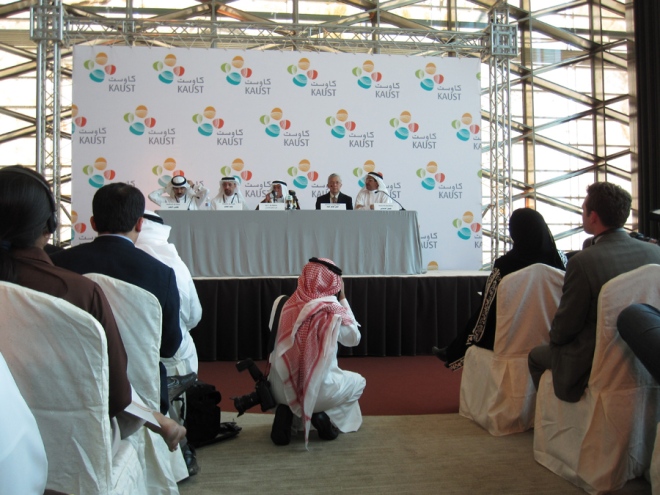 While the House of Wisdom scholars concerned themselves with topics from physics to philosophy, KAUST is not a comprehensive university. Rather, it concentrates on nine science and engineering areas expected to economically diversify Saudi Arabia (and Saudi Aramco) beyond oil. Its research may have practical applications such as water desalination, pollution remediation; the genetic engineering of more draught-tolerant plants, and the development of stable and cost-effective solar cells. At the inauguration day press conference, Ali Ibrahim Al-Naimi, Minister of Petroleum and Mineral Resources and Chairman of the KAUST Board of Trustees said, “Saudi Arabia aspires to export as much solar energy in the future as it exports oil now.”
While the House of Wisdom scholars concerned themselves with topics from physics to philosophy, KAUST is not a comprehensive university. Rather, it concentrates on nine science and engineering areas expected to economically diversify Saudi Arabia (and Saudi Aramco) beyond oil. Its research may have practical applications such as water desalination, pollution remediation; the genetic engineering of more draught-tolerant plants, and the development of stable and cost-effective solar cells. At the inauguration day press conference, Ali Ibrahim Al-Naimi, Minister of Petroleum and Mineral Resources and Chairman of the KAUST Board of Trustees said, “Saudi Arabia aspires to export as much solar energy in the future as it exports oil now.”
Research breakthroughs and the transfer of these new technologies to regional companies are expected to lead to economic growth and high-paying jobs. President Choon Fong Shih likes to call KAUST “Stanford by the Sea.” “Intellectual property,” he told GlobalHigherEd, is “is not an issue”—all discoveries by KAUST researchers become the property of KAUST. For international partnerships, agreements have been made to share intellectual property rights.
International partnerships
Thanks to a phenomenal endowment (waqf) exceeding US$10 billion, KAUST has succeeded in enlisting prestigious partners. Regardless of whether or not these initial collaboration agreements grow into durable long-term partnerships, KAUST’s campaign to attract international partners is, as Robert A. Jones observes, “remarkable for its subtle understanding of how high-level science research proceeds.”
All KAUST research is to be incubated in the context of international partnerships. KAUST’s Academic Excellence Alliance program provides roughly $25 million to foreign universities (Berkeley, Cambridge, Stanford, University of Texas at Austin, and Imperial College London) to advise KAUST on hiring and curricula. In addition to supporting researchers based on its campus, KAUST also provides generous grants to researchers abroad, with expectations of collaboration and participation in researcher and student exchanges with KAUST. Its Global Research Partnership grants of up to $25 million over five years will support to centers at Cornell, Oxford, Stanford, and Texas A&M, and three other “centers-in-development.” KAUST also funds individual investigators’ research projects with grants of $10 million each. These professors will be expected to visit KAUST each year for three weeks to three months.
In addition to linking its external grants to researcher exchange, KAUST also uses scholarships to develop human capital for the region. This semester, 374 men and women begin their graduate work; another 443 will join in 2010. Only 15% are Saudi, but many others have ties to the Middle East. While the Kingdom has long sent talented Saudi students abroad to study, it can now attract foreign students as well, a long-term investment expected to yield a global network of industry and government leaders with ties to Saudi Arabia. It is a strategy similar to the U.S. Fulbright Program and more extensively employed by organizations such as the German Academic Exchange Service.
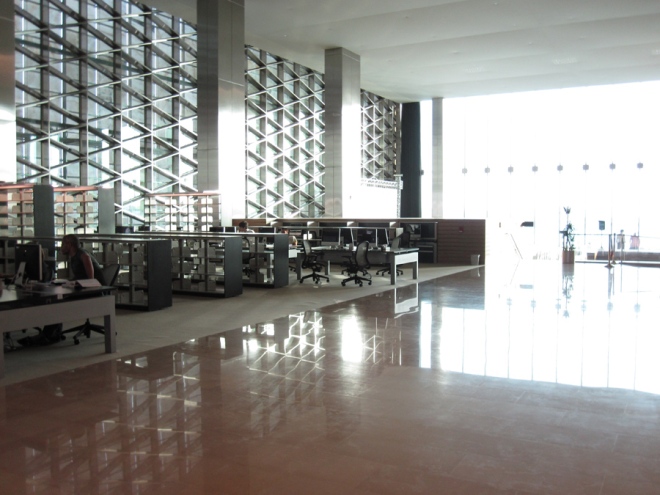 Recruiting talented students and faculty
Recruiting talented students and faculty
KAUST counts on exciting research opportunities and first-rate infrastructure to lure researchers. President Shih told GlobalHigherEd that KAUST is “not looking for a typical academic, but for someone who wants to do something big.” He wants intellectually and culturally adventurous “faculty who want to make a contribution to this part of the world, who want to learn something about this culture.” KAUST has successfully recruited many Middle Easterners based outside the region. How long KAUST will be able to retain faculty within its compound is another question.
KAUST has much to offer the research-focused. It boasts state-of-the-art facilities; “Shaheen,” the world’s 14th fastest supercomputer; and CORNEA, a 3-D “cave” that allows footie- and 3D-goggle-clad visualization researchers to walk inside models of spatial and acoustical environments, such as those underground. Although most of its holdings have yet to arrive, KAUST’s library will soon provide access to 2,000 journals and 10 online databases, interlibrary loan services, and a wide selection of general interest books. KAUST offers faculty competitive salaries (estimated at 1.5 to 2 times US salaries, tax-free, plus many benefits), and—perhaps more importantly—generous multi-year research grants.
Students were recruited from their undergraduate institutions through the Institute of International Education (IIE), on the board of which KAUST advisor Karen Holbrook, also part of the Washington Advisory Group, serves. The KAUST Discovery Scholarship provides all students with paid housing, travel, and generous stipends. It was not only research and funding that attracted many to KAUST, but also the chance to study in an internationally rich context. Students reported activities including camel rides, regional excursions, and exercises to explore cultural differences in communication styles. Michelle Gatz, who graduated from UW-Madison’s mechanical engineering program in 2009, was recruited to do graduate work at KAUST. Gesturing with hands beautifully hennaed from a recent trip to Bahrain, Gatz exudes enthusiasm not only for the scientific opportunities she has at KAUST, but also the cultural ones. She is learning about Islam and Saudi Arabia, and meeting people from around the world. “Everyone here,” she said, “has been so nice.”
Together with KAUST staff, students and faculty form a small city with residents from 70 countries. A city, President Shih says, “with rich and diverse DNA.” Asked how KAUST’s diverse human resources will be engaged to promote understanding around issues of culture and gender, President Shih said he prefers to focus on KAUST’s exciting scientific challenges and how science brings people together: only “when there is nothing exciting, then we focus on differences.”
Culture and gender issues
Many observers are excited about the opening of Saudi Arabia’s first university that allows men and women to interact directly. All other Saudi universities are single-sex; when women are taught by male professors, contact is technologically mediated. A coeducational foundation was undeniably necessary for KAUST to engage prestigious foreign partners and compete for talent internationally, yet some Saudi-based critics object to KAUST’s relaxation of this social taboo. Other critics simply doubt that Saudi Arabia’s students and staff, trained in a secondary education system that emphasizes learning by rote, will be prepared for the demands of a modern, world-class research university. How will the Western academic model transfer into Saudi Arabia’s restrictive social context?
It was difficult to find KAUST officials and staff willing to address such questions. When asked if KAUST had provided training to address gender issues, a female professor replied, “there was a program—they called it a cultural program. It included this. Students had many questions about this.” KAUST divides the responsibility for student advising between a research advisor and an academic advisor who could address issues—including cultural ones—related to degree completion. If KAUST’s model of divided responsibility is not an effort to reduce research supervisor’ workload, but is rather an effort to broaden the network of senior advisors on whom early-career researchers rely, it could be a successful new model—perhaps one from which the West can learn.
Will KAUST be able to attract the most promising women scientists? At the press conference, Dr. Jasmeen Merzaban, Assistant Professor of Biochemistry at KAUST said, “For me coming to Saudi Arabia has been an amazing experience.” She said she has encountered no barriers, in that research is “all based on science.” Her colleague Dr. Niveen M. Khashab, Assistant Professor of Chemical Science and Environmental Science and Engineering, cited the level of infrastructure and interest at the biggest attraction—KAUST has “everything that any assistant professor, regardless of gender, would look for.” She explained, “he—he or she—would look for interest in the research, funding, and just being in a successful environment.” Al-Naimi, Minister of Petroleum and Mineral Resources and Chairman of the KAUST Board of Trustees, implored the press to “focus on the great minds, rather than gender, please. Thank you.”
Clearly, KAUST’s architects have given careful attention to issues of culture and gender awareness within the university compound. Officials’ resistance to discussing these efforts publicly suggests the seriousness of the social pressure KAUST faces in Saudi Arabia, and attests to the extreme care being taken to safeguard this audacious scientific—and social—experiment.
Advancing Saudia Arabia, and the world
Already, KAUST is a remarkable achievement. It gives the striking impression that, in Saudi Arabia, anything is possible. One of the most important legacies of the House of Wisdom, as Jonathan Lyons explains in his new book, is “the notion that religion and science, faith and reason, could coexist.” KAUST aims to reflect this legacy for the advancement of Saudi Arabia and the world, making the region a hub for sustainable technologies and demonstrating the value of intercultural collaboration.
But it is also clear how strongly the KAUST vision is linked to King Abdullah. The King is 85 years old, and Saudi succession is uncertain. Ultimately KAUST’s success may depend on its ability to strike the right balance between protective control and open inquiry. Tangible technological and economic outcomes will be important in stirring the pride of the Saudi population as they turn to developing their rich human resources.
~~~~~~~~~~~~~~~~~
~~~~~~~~~~~~~~~~~
Part II: Postcards from Saudi Arabia: The KAUST inauguration
Public photography was legalized in Saudi Arabia in 2006 by a royal decree, hailed as a step towards promoting tourism.
In spite of this, few tourists visit the Kingdom. Getting a visa is difficult, and most visitors are religious pilgrims, migrant workers, and foreigners who have family or business there. Yet some 2500 heads of state, business leaders, university officials, researchers, and prospective KAUST job candidates—and nearly 100 members of the media—poured into Jeddah last week for the KAUST inauguration.
Many of us looked for postcards to send to our friends and families, but there were none to be found! So for those interested in more informal impressions of the experience, I post a few here.
<><><><><><><><><><><><><><><><><><><><><><>
<><><><><><><><><><><><><><><><><><><><><><>
Shopping malls are an important hub for public recreation in Saudi Arabia. Though in many “public” places, like at this Starbucks, there are semi-private areas for women and families. Some journalists and I visited this Jeddah mall to find gifts for our families. One colleague bought his daughter a Barbie-like doll. There were two categories to choose from: “indoor fashion” and “outdoor fashion” dolls.
<><><><><><><><><><><><><><><><><><><><><><>
KAUST arranged a tour to the Altayebat International City for Sciences and Knowledge, where the knowledgeable staff explained their impressive collections of regional art and artifacts. This architectural engineer designed some amazing exhibitions of Saudi Arabia’s natural regions and heritage. While enjoying the air conditioning, I was completely surrounded the sand, water, wildlife, culture, and sky of the Red Sea! KAUST CORNEA 3-D visualization team–you guys should check this out!
<><><><><><><><><><><><><><><><><><><><><><>
As the KAUST campus cannot yet support big groups of visitors, we stayed in Jeddah hotels and made the hour-long escorted bus trip each day. As we approached the campus, we passed giant billboards heralding KAUST, flags from around the world, multiple security checkpoints, and workers landscaping the roadside.
<><><><><><><><><><><><><><><><><><><><><><>
The campus was stunning! The journalists would have liked to have toured more of it, but our access was restricted to a few buildings.
<><><><><><><><><><><><><><><><><><><><><><>
The library has the most inspiring view of the Red Sea. Most of its holdings have not yet arrived, but it already had an impressive collection of general books. Works by Edward Said and Noam Chomsky were subtly displayed. The media spent many hours here drinking coffee while security was ensured for King Abdullah’s visit.
<><><><><><><><><><><><><><><><><><><><><><>
Catching a ride back to Jeddah with a staff member, I managed to catch a glimpse of a finished condo, thoughtfully furnished with everything from Internet access to frying pans—the cupboards were even stocked with food. We stopped to fill the tank–gas at KAUST would have cost 0.60 Saudi Arabian riyal/liter, except that it, too, was free. (I calculated $0.61/gallon and realized—the riyal is pegged to the dollar at the liter/gallon ratio!)
<><><><><><><><><><><><><><><><><><><><><><>
Guests filled a gigantic air-conditioned tent specially erected for the KAUST inauguration. Just as striking as the research exhibitions was the mix of guests: Saudi men in tailored white thobes, Western men in smart dark suits, Saudi women in abayas and hijab, Western women in colorful skirt suits or long evening gowns peeking out from underneath their abayas. The PR firm had suggested I wear a suit, but I felt more comfortable in my elegant borrowed abaya.
<><><><><><><><><><><><><><><><><><><><><><>
Eight curvy plasma screens spanned the massive auditorium. The lights dimmed, and short film segments introduced KAUST’s mission, philosophy, and people. Each film chapter was introduced with a proverb. “Hearts filled with faith,” one read, “are the foundation of each vision and the source for all truth.” KAUST students, clustered in the back of the auditorium, whooped and applauded when their friends appeared on screen.
<><><><><><><><><><><><><><><><><><><><><><>
Following speeches by KAUST officials and the Saudi Arabian national anthem, King Abdullah took the podium. In his speech, the King compared KAUST to the “House of Wisdom” and extolled the value of international collaboration in education and research.
<><><><><><><><><><><><><><><><><><><><><><>
After King Abdullah’s address, the plasma screens parted and receded to reveal the Red Sea. Massive fireworks erupted over KAUST’s signature “Breakwater Beacon,” and were joined by dancing fountains (easily surpassing the Bellagio in Las Vegas). Beaming Saudis and world-weary foreign correspondents smiled at each other, pleased to be sharing this experience.
<><><><><><><><><><><><><><><><><><><><><><>
Following the banquet, we waited for hours for our assigned buses back to Jeddah. University leaders and journalists lingered over Arabic sweets and cans of 7-up with Saudi Aramco and KAUST employees. I finally made it back to the hotel at 4 a.m., nearly 22 hours after the media security check began. The scrappier correspondents, on breaks from demanding Middle Eastern posts, had elbowed and cajoled their way onto earlier buses.
Kimberly Coulter
~~~~~~~~~~~~~~~~~
Editor’s note: see below for a YouTube clip of the noted fireworks segment:
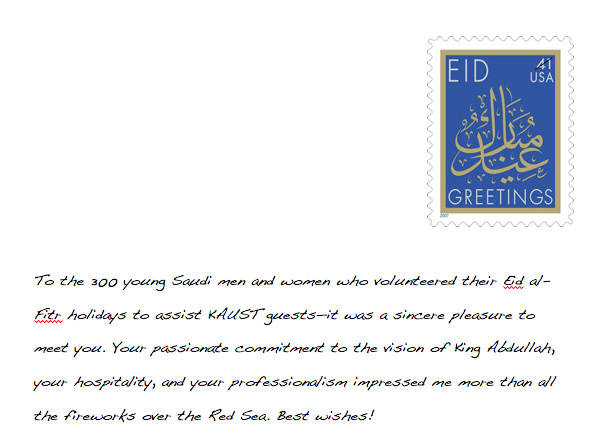
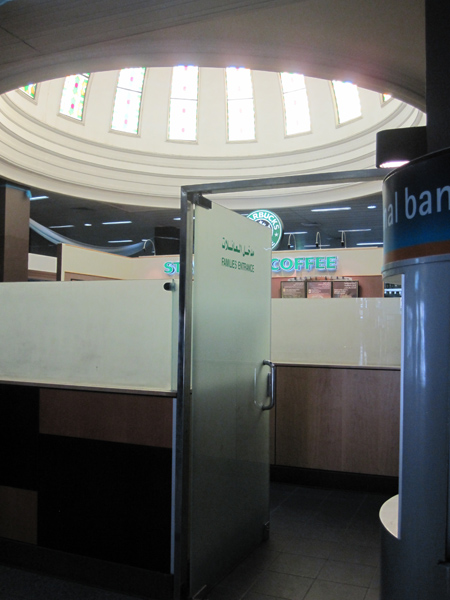

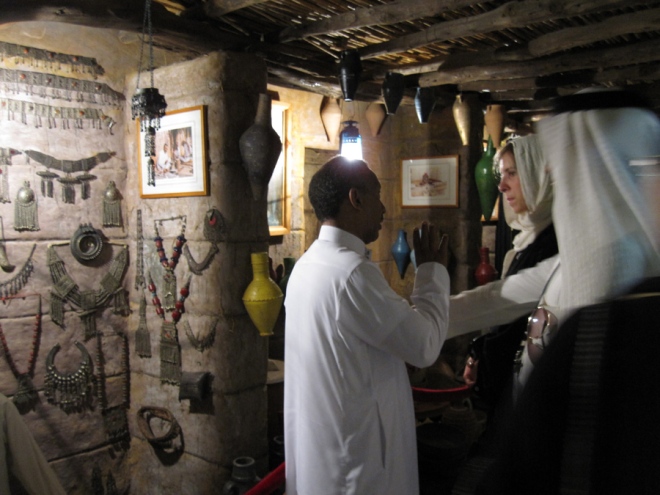

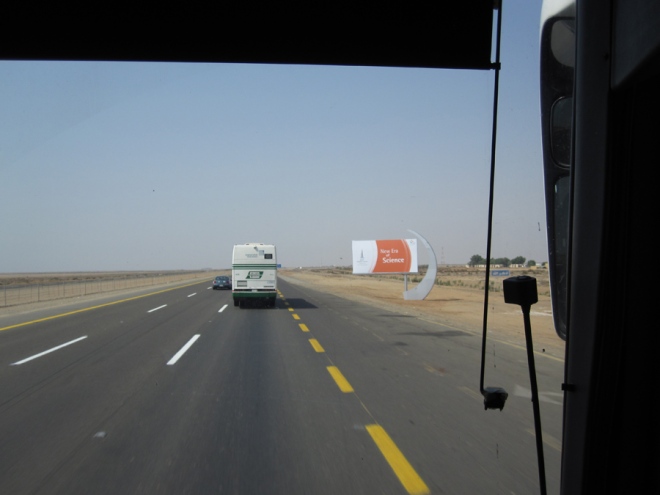
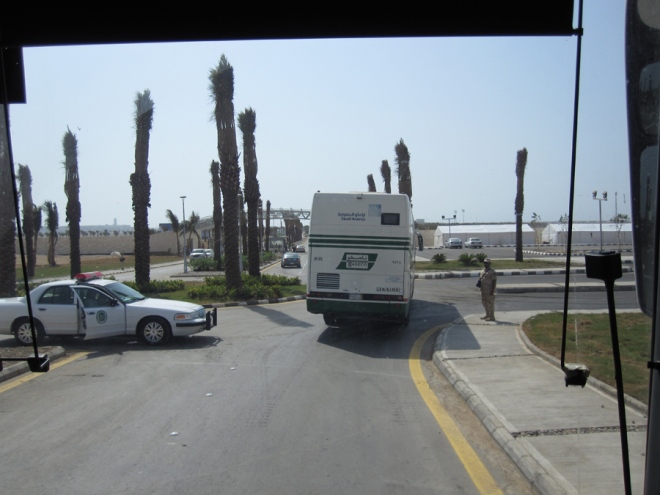

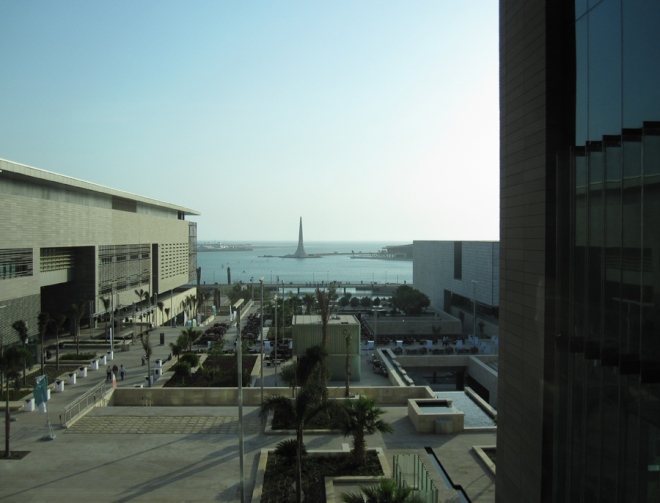
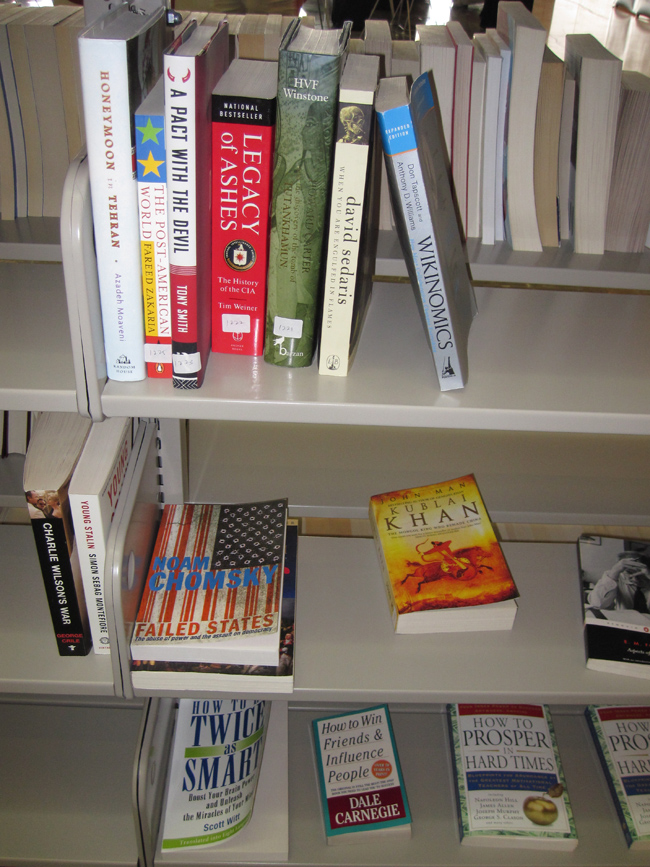

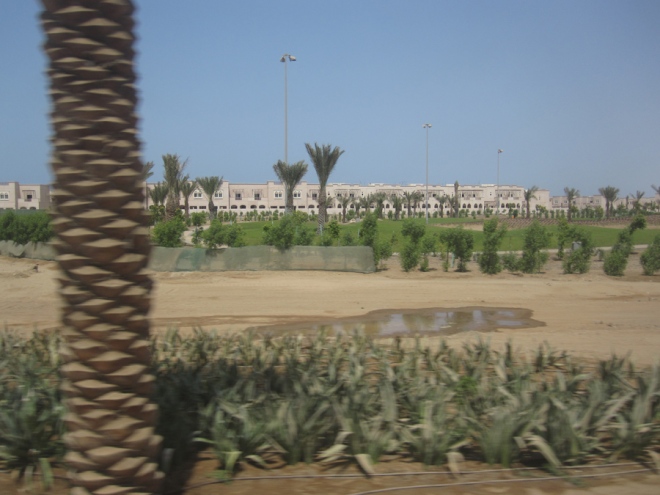
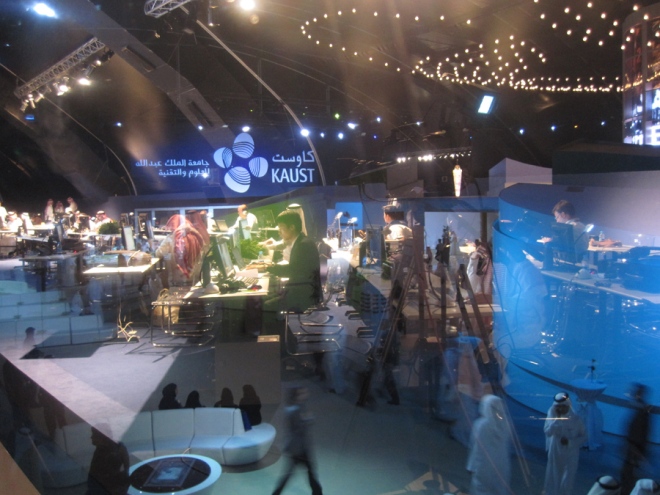
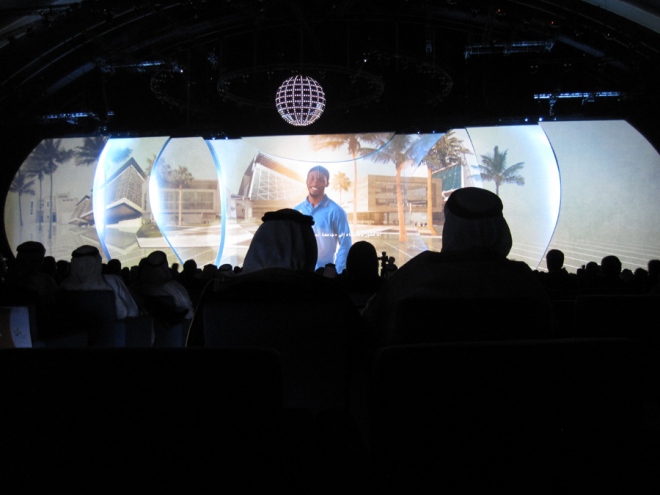
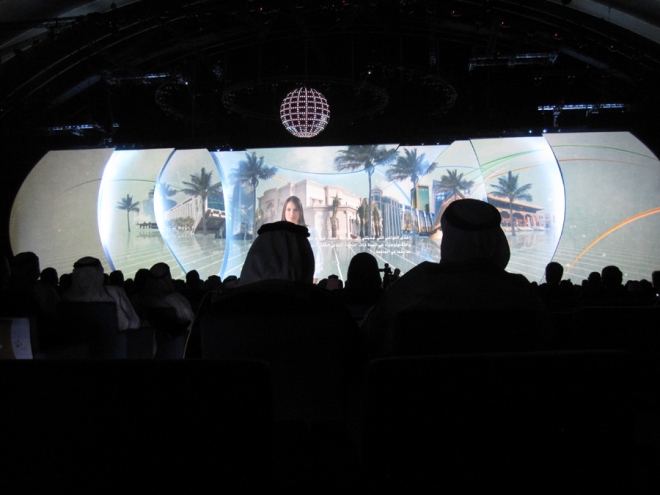

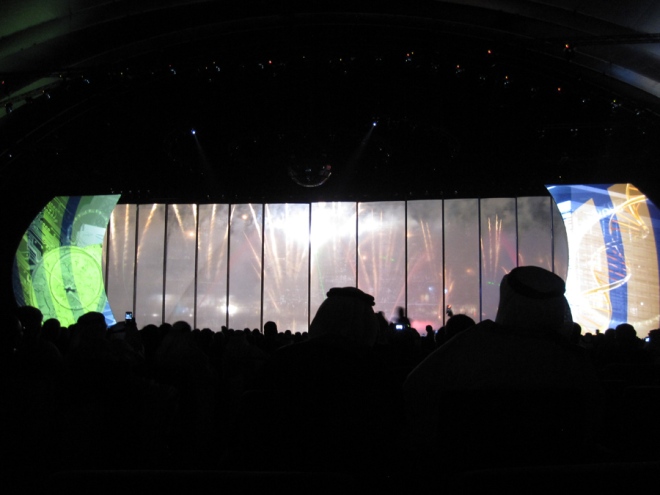
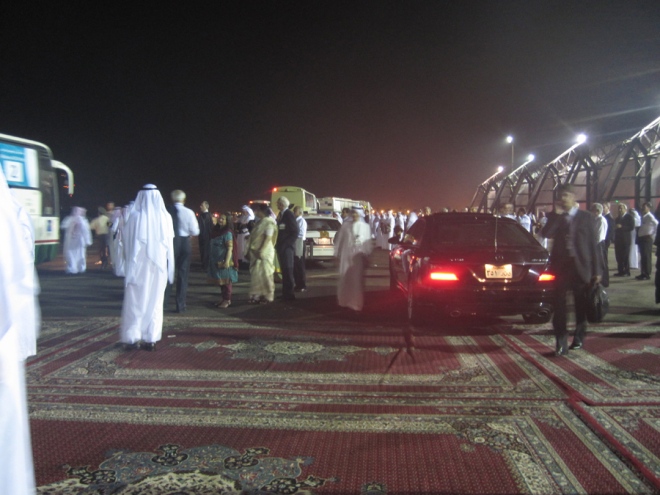
Pingback: Saudi Arabia: KAUST – elearnspace
Pingback: Media Literacy: Making Sense Of New Technologies And Media by George Siemens - Oct 10 09 | jatiN mahindrA doT coM
Pingback: Media Literacy: Making Sense Of New Technologies And Media by George Siemens – Oct 10 09 « Argument
Pingback: Media Literacy: Making Sense Of New Technologies And Media by George Siemens – Oct 10 09 | BonusWealthy.Com's Blog
Pingback: New Latin American integration universities launched « GlobalHigherEd